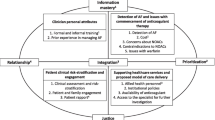Abstract
Background
Chronic complex diseases like atrial fibrillation have potential long-term economical and personal consequences. Shared decision-making principles may promote therapeutic compliance, satisfaction and outcomes. Pharmacists, as patient-advocates, play a key role in guiding them through complex clinical decisions about their chronic disease management and anticoagulation choices.
Aim
To evaluate the impact of pharmacist-led shared decision making on patients’ satisfaction and appropriateness of their anticoagulation therapy in newly diagnosed atrial fibrillation patients.
Methods
A prospective 2-phase before and after single-centre study was conducted in an Australian hospital. Phase 1 provided usual care, and patients’ satisfaction and appropriateness of their anticoagulation therapy were evaluated. Phase-2 assessed the impact on satisfaction and appropriateness of anticoagulant therapy following pharmacist-led interventions of shared decision making to promote patients’ involvement.
Results
Patients with pharmacist-led shared decision making reported higher degree of appropriateness of anticoagulation therapy and satisfaction (36% vs 92%, P < 0.001; 25% vs 68, P < 0.001), respectively. Additionally, patients who had a pharmacist input during their hospital stay received guideline-recommended anticoagulant therapy and reported satisfaction with their management was also higher in stage 2 (21% vs 65%, p < 0.001).
Conclusion
The study highlights pharmacist-led shared decision making in atrial fibrillation that contributes to patient satisfaction and appropriateness of therapy.

Similar content being viewed by others
Data availability
Data presented in this manuscript is available upon reasonable request.
References
January CT, Wann LS, Calkins H et al (2019) 2019 AHA/ACC/HRS focused update of the 2014 AHA/ACC/HRS guideline for the management of patients with atrial fibrillation: a report of the American College of Cardiology/American Heart Association Task Force on Clinical Practice Guidelines and the Heart Rhythm Society in Collaboration With the Society of Thoracic Surgeons. Circulation 140(2):e125–e151. https://doi.org/10.1161/CIR.0000000000000665
Bajpai A, Camm AJ, Savelieva I (2007) Epidemiology and economic burden of atrial fibrillation. US Cardiol 4(1):14–17 Accessed on 14/7/2020. https://www.uscjournal.com/articles/epidemiology-economic-burden-af
National Clinical Guideline Centre (UK) (2014) Atrial fibrillation: the management of atrial fibrillation. National Institute for Health and Care Excellence (UK).Available from: https://www.nice.org.uk/guidance/cg180/chapter/1-Recommendations#personalised-package-of-care-and-information-2. Accessed April 2020
Lindhiem O, Bennett CB, Trentacosta CJ, McLear C (2014) Client preferences affect treatment satisfaction, completion, and clinical outcome: a meta-analysis. Clin Psychol Rev 34(6):506–517. https://doi.org/10.1016/j.cpr.2014.06.002
Aljumah K, Hassali MA (2015) Impact of pharmacist intervention on adherence and measurable patient outcomes among depressed patients: a randomised controlled study. BMC Psychiatry 15:219. https://doi.org/10.1186/s12888-015-0605-8
Smith CA, Chang E, Gallego G, Balneaves LG (2017) An education intervention to improve health literacy and decision making about supporting self-care among older Australians: a study protocol for a randomised controlled trial. Trials 18(1):441. https://doi.org/10.1186/s13063-017-2182-2
Holbrook A, Labiris R, Goldsmith CH et al (2007) Influence of decision aids on patient preferences for anticoagulant therapy: a randomized trial. CMAJ 176(11):1583–1587. https://doi.org/10.1503/cmaj.060837
Virdee MS, Stewart D (2017) Optimizing the use of oral anticoagulant therapy for atrial fibrillation in primary care: a pharmacist-led intervention. Int J Clin Pharm 39(1):173–180. https://doi.org/10.1007/s11096-016-0419-x
Colligan E, Metzler A, Tiryaki E (2017) Shared decision-making in multiple sclerosis. Mult Scler 23(2):185–190. https://doi.org/10.1177/1352458516671204
Medrano Martínez V, Callejo-Domínguez JM et al (2015) Migraine education brochures and patient-perceived satisfaction. Neurologia (Barcelona, Spain) 30(8):472–478. https://doi.org/10.1016/j.nrl.2014.04.010
Hyrkas K, Wiggins M (2014) A comparison of usual care, a patient-centred education intervention and motivational interviewing to improve medication adherence and readmissions of adults in an acute-care setting. J Nurs Manag 22(3):350–361. https://doi.org/10.1111/jonm.12221
Weiss MC, Platt J, Riley R et al (2015) Medication decision making and patient outcomes in GP, nurse and pharmacist prescriber consultations. Prim Health Care Res Dev 16(5):513–527. https://doi.org/10.1017/S146342361400053X
Bradford WC (2004) Reaching the visual learner: teaching property through art (September 1, 2011). The Law Teacher Vol. 11. Available at SSRN: https://ssrn.com/abstract=587201
Video games to improve patients’ understanding. Available on: https://blog.rendia.com/how-interactive-patient-education-is-changing-health-care/. Accessed on 17/6/2020
Acknowledgments
The authors would like to thank Stefanie Stattmann and Katharina Heitzeneder for assistance with some of the data collection.
Funding
This research received no specific grant from any funding agency in the public, commercial, or not-for-profit sectors.
Author information
Authors and Affiliations
Contributions
VK & AS contributed to the study conception and design. Material preparation and data analysis were performed by VK. Part of the data collection was completed by SB. The draft of the manuscript was written by VK. All authors commented on previous versions of the manuscript. All authors read and approved the final manuscript.
Corresponding author
Ethics declarations
Conflict of interest
The authors declare that they have no conflict of interest.
Ethics approval
The project was approved by the hospital research and ethics committee. Ethics application number QA/16/PH29. Informed consent was obtained for all patients.
Informed consent
All subjects enrolled into the study voluntarily agreed to participate in the study and signed an informed consent form before any study procedure in compliance with the Declaration of Helsinki.
Additional information
Publisher’s note
Springer Nature remains neutral with regard to jurisdictional claims in published maps and institutional affiliations.
Rights and permissions
About this article
Cite this article
Khalil, V., Blackley, S. & Subramaniam, A. Evaluation of a pharmacist-led shared decision-making in atrial fibrillation and patients’ satisfaction—a before and after pilot study. Ir J Med Sci 190, 819–824 (2021). https://doi.org/10.1007/s11845-020-02343-y
Received:
Accepted:
Published:
Issue Date:
DOI: https://doi.org/10.1007/s11845-020-02343-y




